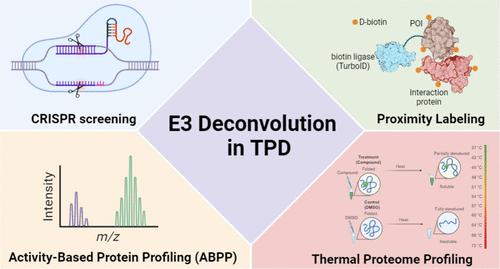当前位置:
X-MOL 学术
›
J. Med. Chem.
›
论文详情
Our official English website, www.x-mol.net, welcomes your
feedback! (Note: you will need to create a separate account there.)
Targeted Protein Degradation: Current and Emerging Approaches for E3 Ligase Deconvolution
Journal of Medicinal Chemistry ( IF 6.8 ) Pub Date : 2024-07-09 , DOI: 10.1021/acs.jmedchem.4c00723 Yufeng Xiao 1 , Yaxia Yuan 2, 3 , Yi Liu 1 , Zongtao Lin 4 , Guangrong Zheng 1 , Daohong Zhou 2, 3 , Dongwen Lv 2, 3
Journal of Medicinal Chemistry ( IF 6.8 ) Pub Date : 2024-07-09 , DOI: 10.1021/acs.jmedchem.4c00723 Yufeng Xiao 1 , Yaxia Yuan 2, 3 , Yi Liu 1 , Zongtao Lin 4 , Guangrong Zheng 1 , Daohong Zhou 2, 3 , Dongwen Lv 2, 3
Affiliation

|
Targeted protein degradation (TPD), including the use of proteolysis-targeting chimeras (PROTACs) and molecular glue degraders (MGDs) to degrade proteins, is an emerging strategy to develop novel therapies for cancer and beyond. PROTACs or MGDs function by inducing the proximity between an E3 ligase and a protein of interest (POI), leading to ubiquitination and consequent proteasomal degradation of the POI. Notably, one major issue in TPD is the lack of ligandable E3 ligases, as current studies predominantly use CUL4CRBN and CUL2VHL. The TPD community is seeking to expand the landscape of ligandable E3 ligases, but most discoveries rely on phenotypic screens or serendipity, necessitating systematic target deconvolution. Here, we examine and discuss both current and emerging E3 ligase deconvolution approaches for degraders discovered from phenotypic screens or monovalent glue chemistry campaigns, highlighting future prospects for identifying more ligandable E3 ligases.
中文翻译:

靶向蛋白质降解:E3 连接酶解卷积的当前和新兴方法
靶向蛋白质降解(TPD),包括使用蛋白水解靶向嵌合体(PROTAC)和分子胶降解剂(MGD)来降解蛋白质,是开发癌症及其他疾病新疗法的新兴策略。 PROTAC 或 MGD 通过诱导 E3 连接酶和目标蛋白 (POI) 之间的接近来发挥作用,导致 POI 泛素化和随后的蛋白酶体降解。值得注意的是,TPD 的一个主要问题是缺乏可配体的 E3 连接酶,因为目前的研究主要使用 CUL4 CRBN和 CUL2 VHL 。 TPD 社区正在寻求扩大可配体 E3 连接酶的应用范围,但大多数发现依赖于表型筛选或意外发现,因此需要系统性靶点解卷积。在这里,我们研究并讨论了当前和新兴的 E3 连接酶反卷积方法,用于从表型筛选或单价胶化学活动中发现的降解剂,强调了识别更多可配体 E3 连接酶的未来前景。
更新日期:2024-07-09
中文翻译:

靶向蛋白质降解:E3 连接酶解卷积的当前和新兴方法
靶向蛋白质降解(TPD),包括使用蛋白水解靶向嵌合体(PROTAC)和分子胶降解剂(MGD)来降解蛋白质,是开发癌症及其他疾病新疗法的新兴策略。 PROTAC 或 MGD 通过诱导 E3 连接酶和目标蛋白 (POI) 之间的接近来发挥作用,导致 POI 泛素化和随后的蛋白酶体降解。值得注意的是,TPD 的一个主要问题是缺乏可配体的 E3 连接酶,因为目前的研究主要使用 CUL4 CRBN和 CUL2 VHL 。 TPD 社区正在寻求扩大可配体 E3 连接酶的应用范围,但大多数发现依赖于表型筛选或意外发现,因此需要系统性靶点解卷积。在这里,我们研究并讨论了当前和新兴的 E3 连接酶反卷积方法,用于从表型筛选或单价胶化学活动中发现的降解剂,强调了识别更多可配体 E3 连接酶的未来前景。
















































 京公网安备 11010802027423号
京公网安备 11010802027423号